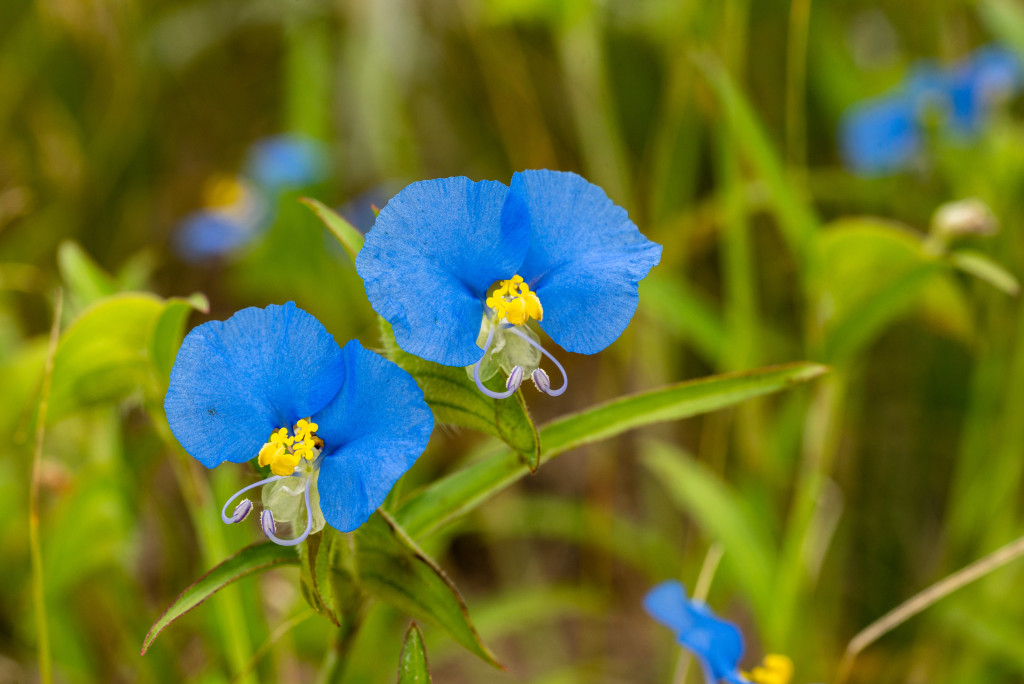Enlarge

Story and photos by Gerry Steinauer, Botanist
As their name implies, each dayflower blossom is fleeting. New flowers that open to greet the rising sun close about noon and wither by dusk. The lovely blue flowers are as delicate as they are short-lived. When rubbed between one’s fingers, their petals quickly disintegrate into a watery ooze.
Belonging to the spiderwort family (Commelinaceae), two dayflower species, both growing up to a foot tall, inhabit Nebraska. Slender dayflower (Commelina erecta) is a wide-ranging perennial native to the Americas, Africa and western Asia. They grow alone or in loose clusters in sand prairies in the western half of our state, including the Sandhills. Oddly, the plant is absent from apparently suitable, sandy habitats in eastern Nebraska.
Common dayflower (C. communis), native to Asia, was introduced to North America, likely as an ornamental, and first collected in Nebraska in 1905. Limited to the eastern half of the state, the sprawling annual is mainly a yard and garden weed in clay to somewhat sandy soils. The plant rapidly spreads by rooting from nodes on its reclining stems and, in infested gardens, can form dense tangles among summer crops.

Characteristic of the spiderwort family, dayflowers have distinct, parallel veins running the length of their leaves. Common dayflower leaves are broadly lance-shaped and hairless, while slender dayflower leaves are narrowly lance-shaped and somewhat hairy. Both species’ flower heads are hidden within a wide, folded, leafy bract from which individual flowers emerge throughout the summer and into early autumn.
Commelina flowers have two bright-blue, showy petals and a third petal that is small and translucent or sometimes absent. When present, it sits below the two showy petals.
These highly-modified flowers are designed for pollination by mid-sized bees and flies. The flowers contain no sweet-scented nectar to attract and reward pollinating insects. Instead, the vivid blue petals catch the eye of pollinators, while the four yellow, cross-shaped anthers draw them into the flower. In most plants, these anthers contain a rich meal of pollen, but in dayflowers they contain none.

While fruitlessly probing the infertile, yellow anthers, the insects’ abdomen flanks are dabbed with pollen from two blue, fertile anthers found at the tips of long filaments that extend outward from the flower. When the duped insects visit another flower, this pollen is transferred to a single female, pollen-receiving stigma found at the tip of a long filament that extends between the two fertile anthers. While pollination is complete, the insects are still hungry.
The dayflowers’ deceptive flowers are just one of the plant kingdom’s many unique floral designs to ensure pollination and survival on this remarkable planet called Earth. ■
A Botanical Jokester

The 18th century Swedish botanist Carl Linnaeus bestowed dayflowers with the genus name Commelina in honor of his friends: the Dutch family Commelin. One version of the story states that the flowers’ two bright blue petals represent the families’ renowned botanists: Jan and his nephew Caspar. The third small, colorless petal represents Jan’s brother Casparus, who was merely a book seller and newspaper publisher. Linnaeus deserves credit as this is about as good as botanical humor gets, excluding, of course, the classic joke about the rabbi, the priest and the botanist.
The post Deceptive Dayflowers appeared first on Nebraskaland Magazine.
















